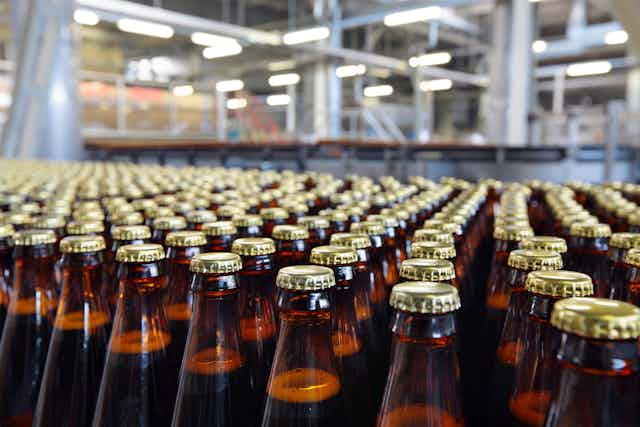Alcohol producers and retailers have long argued that their goal is a world where everyone drinks responsibly and heavy drinking is a thing of the past. As a result, the alcohol industry claims to be part of the solution to the UK’s drink problem rather than part of the problem. In our latest research, published in Addiction, we examine the credibility of this claim.
We used data from two major national surveys, the Health Survey for England and the Living Costs and Food Survey. Taken together these surveys give us an insight into the drinking and alcohol buying habits of almost 27,000 people.
Sobering figures
Using this data, we calculated that over 77% of all alcohol sold in England in 2013-14 was drunk by the 25% of adults who exceeded the UK drinking guidelines of 14 units per week (roughly six pints of beer or one and a half bottles of wine). Crucially for the alcohol industry, these heavy drinkers also account for 68% of revenue from alcohol sales.
If we focus on the heaviest drinkers – men drinking over 50 units a week and women drinking more than 35 units – then things look even worse. The 4% of adults drinking at this level accounted for almost a quarter (23%) of alcohol industry revenue.
Not all parts of the alcohol industry are equally reliant on the revenue from heavy drinkers. A greater proportion of beer revenue comes from those drinking above the guidelines than spirits (67% compared with 50%). Similarly, a much larger proportion of sales revenue for supermarkets and off-licences comes from heavy drinkers than revenue in pubs, clubs and restaurants (81% compared with 60%). This suggests that the industry’s reliance on heavy drinkers may have increased over time as alcohol consumption has shifted from drinking in the pub to drinking at home.
Doesn’t add up
These figures don’t look good for the alcohol industry. How can such a reliance on heavy drinkers for their revenue be compatible with a desire to see everyone drinking responsibly? It turns out that the industry has an answer for this: they will encourage us all to “drink less, but drink better”.
If we all drink fewer drinks but pay more for each one, would everyone win? Our analysis suggests that the answer is an emphatic no.
We looked at a scenario where every drinker who exceeds the UK guidelines reduced their drinking to 14 units per week and calculated how much the price of alcohol would have to increase to sustain industry sales revenue at its current level. For drinkers, the answers don’t make for happy reading. The average price of a pint in a pub would have to jump from £3.51 to £6.15, while the average cost of a bottle of wine in your local shop or supermarket would rocket from £5.50 to £9.86.
It may be the case that some sectors of the alcohol market, such as small producers of craft beers or spirits, could sustain such price rises, but it seems unlikely that they could be achieved across the entire market.

Responsible deal?
One of the few alcohol policies of any note to come out of Westminster in the past eight years was the so-called “responsibility deal”, in which over 100 alcohol makers and sellers committed to “foster a culture of responsible drinking, which will help people to drink within the guidelines”.
Later research showed that this commitment led to little in the way of meaningful change and is unlikely to have achieved these goals.
In highlighting the implausibility of the alcohol industry’s argument that it wants a world where everyone drinks moderately, our analysis suggests that this approach was doomed from the outset. Large sections of the industry would not survive if this were to happen, calling into question whether it is appropriate to include them in decisions about future alcohol policy.

